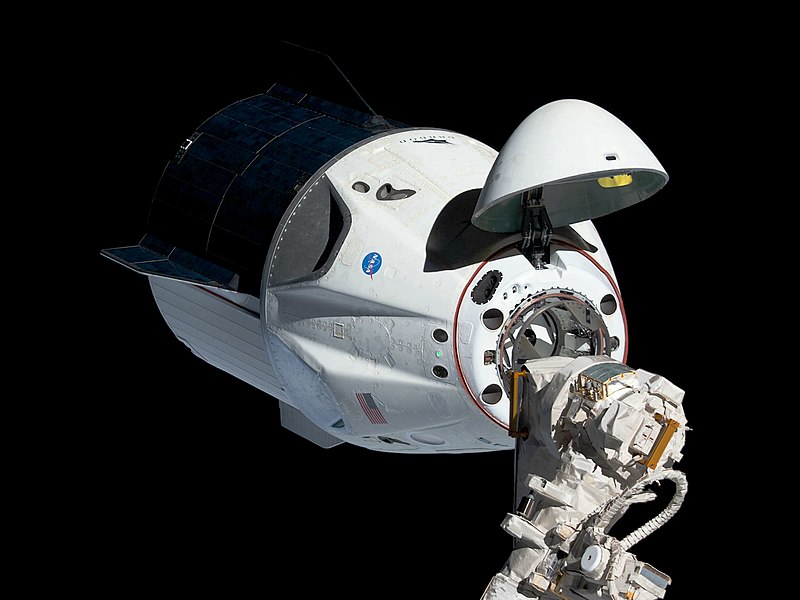
Artist's depiction of the proposed Japanese IKAROS space-probe using a solar sail powered by a powerful ground-based laser.
(Image Sources: Wikipedia.org, By Andrzej Mirecki - Own work, CC BY-SA 3.0, https://commons.wikimedia.org/w/index.php?curid=14656159)
By Glenn A. Walsh
Reporting for SpaceWatchtower
Solar sails which could propel
spacecraft to other planets, or possibly even to distant stars, have
been a dream of scientists since the 19th century. A
light-sail design would accelerate a spacecraft slowly, but it would
speed-up to high speeds over a longer period of time.
Particularly for possible interstellar
travel, our current use of rockets with chemical propellants would
not be efficient or effective. And, a large part of the thrust has to
be used just to transport the heavy fuel needed for later in the
mission.
Originally conceived to take advantage
of the solar wind of our Sun (and, perhaps, that of other stars),
today light-sail spacecraft are more likely to use strong
ground-based (and, perhaps, some day space-based) lasers for such
spacecraft propulsion.
However, when using a ground-based
laser, one potential problem has been to keep the laser-sail
spacecraft from straying away from the laser beam and veering
off-course. Optical scientists from the Chester F. Carlson Center for
Imaging Science at the Rochester Institute of Technology and the BEAM
Engineering for Advanced Measurements are experimenting with
solutions to this problem.
While previous light-sail designs
simply acted like mirrors to reflect the laser-light back to the
source, the new design uses liquid crystals in diffraction gratings
to better stabilize the spacecraft. If the spacecraft starts drifting
toward the left, the new sail deflects light to the right and
visa-versa. Hence, the spacecraft is forced to position itself back
to where the laser beam falls on the center of the sail.
Today, diffraction gratings are used to
help encode music and other information on compact disks and digital
video disks. One of the effects of diffraction, which some people may
be familiar with, is the rainbow effect seen when light is reflected
from a CD or DVD.
The original experiment, which was
successful, simply used diffraction gratings on the left and right
sides of the sail. Now, the researchers are beginning experiments to
test diffraction gratings that could center a spacecraft, no-matter
which direction it drifts (not just to the right or to the left).
They hope that future experiments could be conducted in Earth orbit,
on the International Space Station or a separate satellite.
This research was published by
researchers Ying-Ju Lucy Chu, Nelson V. Tabiryan, and Grover A.
Swartzlander, Jr. in the 2019 December 13 issue of the journal
Physical Review Letters.
In 2016, Breakthrough Starshot
Initiative announced a plan to launch swarms of micro-chip-sized
spacecraft toward the Alpha Centauri star system, the closest
multi-star system to the Earth. Proposed to cost up to $100 million,
the very small spacecraft would include thin, reflective, and very
light-weight laser-light sails, propelled by incredibly powerful
lasers based on Earth. The project proponents hope each spacecraft
could reach speeds close to 20 per-cent of the speed of light,
reaching the Alpha Centauri system 20 years after launch.
Internet Links to Additional Information ---
Solar Sail: Link >>> https://en.wikipedia.org/wiki/Solar_sail
Breakthrough Starshot---
Link 1 >>> http://breakthroughinitiatives.org/initiative/3
Link 2 >>> https://en.wikipedia.org/wiki/Breakthrough_Starshot
Abstract: Research Paper -
"Experimental Verification of a Bigrating Beam Rider."
Ying-Ju Lucy Chu, Nelson V. Tabiryan, and Grover A. Swartzlander, Jr.
Phys. Rev. Lett. 123, 244302 - Published 2019 Dec. 13.
Link >>> https://journals.aps.org/prl/abstract/10.1103/PhysRevLett.123.244302
Related Blog Posts ---
"Nano-Space Probes to Star Alpha Centauri by Laser-Sail ?" Thur., 2017 Dec. 7.
Link >>> https://spacewatchtower.blogspot.com/2017/12/nano-space-probes-to-star-alpha.html
"Laser-Propelled Nano-Space Probe to Reach Alpha Centauri in 20 Years?." Thur., 2016 April 14.
Link >>> https://spacewatchtower.blogspot.com/2016/04/laser-propelled-nano-space-probe-to.html
"Solar Sail Spacecraft Test in 2016." Thur., 2014 July 17.
Link >>> https://spacewatchtower.blogspot.com/2014/07/solar-sail-spacecraft-test-in-2016.html
Source: Glenn A. Walsh Reporting for SpaceWatchtower, a project of Friends of the Zeiss.
Monday, 2020 January 27.
Like This Post? Please Share!
More Astronomy & Science News - SpaceWatchtower Twitter Feed:
Link >>> https://twitter.com/spacewatchtower
Astronomy & Science Links: Link >>> http://buhlplanetarium.tripod.com/#sciencelinks
Want to receive SpaceWatchtower blog posts in your in-box ?
Send request to < spacewatchtower@planetarium.cc >.
gaw
Glenn A. Walsh, Informal Science Educator & Communicator:
< http://buhlplanetarium2.tripod.com/weblog/spacewatchtower/gaw/ >
Electronic Mail: < gawalsh@planetarium.cc >
Project Director, Friends of the Zeiss: < http://buhlplanetarium.tripod.com/fotz/ >
SpaceWatchtower Editor / Author: < http://spacewatchtower.blogspot.com/ >
Formerly Astronomical Observatory Coordinator & Planetarium Lecturer, original Buhl Planetarium & Institute of Popular Science (a.k.a. Buhl Science Center), Pittsburgh's science & technology museum from 1939 to 1991.
Formerly Trustee, Andrew Carnegie Free Library and Music Hall, Pittsburgh suburb of Carnegie, Pennsylvania.
Author of History Web Sites on the Internet --
* Buhl Planetarium, Pittsburgh:
< http://www.planetarium.
* Adler Planetarium, Chicago:
< http://adlerplanetarium.
* Astronomer, Educator, Optician John A. Brashear:
< http://johnbrashear.tripod.com >
* Andrew Carnegie & Carnegie Libraries:
< http://www.andrewcarnegie.

